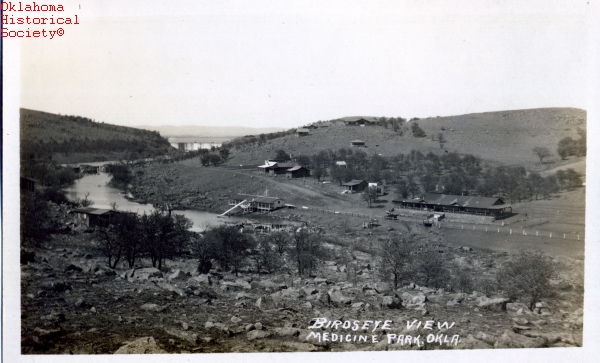MEDICINE PARK.
Located in central Comanche County, Medicine Park is situated northwest of Lawton along State Highway 49, four miles west of Interstate Highway 44. Oklahoma's only historical cobblestone town lies at the foothills of the Wichita Mountains and is named for Medicine Creek, which flows through the center of town. Medicine Park was established on land purchased by John William Elmer Thomas, a future U.S. representative and senator, who envisioned a resort community to utilize the pure medicinal qualities of the creek, which were well known by the Plains Indian residents. Founded in 1908, Thomas named it the Medicine Park Summer Resort and Health Spa. A post office was established on October 13, 1908.
In the 1920s Medicine Park grew and developed under Thomas's vision. Two dams were built, creating Bath Lake for swimming and Lake Gondola for boating and fishing. The Outside Inn, a two-story hotel, opened with an annex that housed a trading post/general store and post office. Sixteen rental cabins as well as concessions and a slide were available at Bath Lake. Advertising outdoor activities, the community had electric power, telephone service, and approximately two hundred thousand visitors annually. Permanent residences were built and a public school constructed. A state fish hatchery was built in 1915, and Thomas donated land to the Oklahoma Press Association for a clubhouse. In 1922 physician Charles Baird opened the Baird Sanatorium and Health Clinic. An Easter pageant was held in the park before being permanently located at The Holy City of the Wichitas in 1935.
When Thomas was elected U.S. senator in 1926, he sold the park to a corporation. Since that sale and subsequent owners, the park continued to decline through the 1960s. Incorporated in 1969, Medicine Park had a population of 483 in 1970 and reached a low of 285 in 1990. With a population of 373 at the turn of the twenty-first century, the town was being revitalized. New municipality infrastructure, preservation projects, and additional businesses improved the community. The 2010 population stood at 382. The April 2020 census reported 409 residents. The Medicine Park Hotel and Annex was listed in the National Register of Historic Places in 1979 (NR 79001991). Medicine Park hosted weekend, holiday, and annual events reminiscent of its early resort atmosphere. Locals and visitors enjoyed Lake Lawtonka, Elmer Thomas Lake, and the Wichita Mountains National Wildlife Refuge. Medicine Park serves as a "bedroom" community for the Lawton-Fort Sill area.
See Also
Bibliography
Linda Paulson Branson, "The Evolution of a Resort Community: Medicine Park, Oklahoma" (M.A. thesis, University of Oklahoma, 1992).
Rex Harlow, "The Playground of Southwestern Oklahoma," Harlow's Weekly 21 (June 2, 1922).
The History of Comanche County, Oklahoma (N.p.: Southwest Oklahoma Genealogical Society, 1985).
"Medicine Park," Vertical File, Research Division, Oklahoma Historical Society, Oklahoma City.
Citation
The following (as per The Chicago Manual of Style, 17th edition) is the preferred citation for articles:
M. Lillian Standfield, “Medicine Park,” The Encyclopedia of Oklahoma History and Culture, https://www.okhistory.org/publications/enc/entry?entry=ME006.
Published January 15, 2010
Last updated
March 25, 2024
© Oklahoma Historical Society


